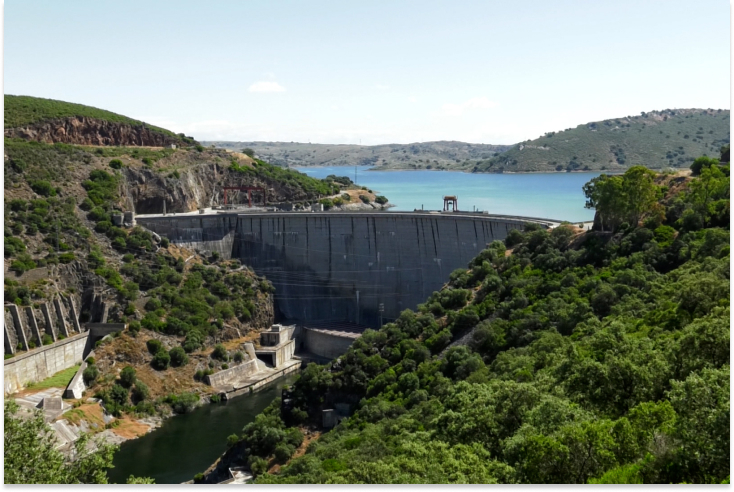Notícia
2024-03-11 13:43:00.0Recebemos sinal verde para o projeto de bombeamento de Valdecañas, na Espanha
- A instalação, com uma potência total de 275 MW, apresenta um sistema de bateria híbrida com capacidade de armazenamento de 15 e 7,5 MWh.
- O projeto reduzirá as emissões em 200.000 toneladas de CO2 por ano e melhorará a qualidade da água na bacia do Tejo.
- Será responsável por criar 165 empregos diretos e outros 500 indiretos.
O Ministério da Transição Ecológica e do Desafio Demográfico da Espanha concedeu autorização administrativa para o projeto de bombeamento de Valdecañas (Cáceres), que melhorará o potencial energético do rio Tejo ao armazenar de maneira sazonal a energia excedente do sistema no reservatório de Valdecañas.
O projeto terá uma potência total de 275 MW e conta com um sistema de bateria híbrida com os grupos geradores. A bateria tem uma capacidade de 15 MW e, quando totalmente carregada, pode atingir 7,5 MWh de energia armazenada. O conjunto de bateria e as unidades hidráulicas juntas apresentam uma reserva de energia de 210 GWh (equivalente a 5,2 milhões de baterias de veículos elétricos).
A capacidade de uma usina reversível de armazenamento por bombeamento permite que grandes quantidades de energia sejam armazenadas e liberadas rapidamente, o que facilita o equilíbrio da rede elétrica, pois a usina funciona como uma "bateria gigante", armazenando energia potencial na forma de água no reservatório superior. Dessa forma, a energia pode ser armazenada quando há excesso de produção e recuperada quando necessário, operando como um "circuito fechado" sem consumo de água. Isso proporciona resiliência em "larga escala" às flutuações de demanda de geração e uma longa vida útil.
A Iberdrola destacou que esse projeto tem um impacto mínimo, já que seu alcance é exclusivamente eletromecânico e não requer a construção de nenhuma infraestrutura civil, uma vez que aproveita a infraestrutura existente e os reservatórios de Valdecañas e Torrejón, sem alterar os níveis operacionais. Além disso, não há necessidade de construir novas linhas de rede de transmissão, já que são utilizadas as que já existem.
A implementação desse projeto de bombeamento possibilitará a redução de 200.000 toneladas de CO2 por ano, graças à maior integração de energias renováveis, e criará 165 empregos diretos e outros 500 indiretos, promovendo assim postos de trabalho qualificados. Também terá um grande impacto na economia da área com a participação das pequenas e médias empresas da província, o que também ajudará a fixar a população.
Tecnologia de ponta
O projeto de bombeamento utiliza soluções tecnológicas de ponta, usando um sistema híbrido de baterias que permite a rápida partida das unidades no modo de bombeamento, além de otimizar a capacidade de regular a produção ou a demanda para a integração de energias renováveis no sistema elétrico, combinando a resposta rápida da bateria com a solidez energética da turbina.
Geração hidrelétrica bombeada em Alcântara
Esse bombeamento faz parte do compromisso da Iberdrola com o armazenamento hidrelétrico. Na bacia do Tejo, também está em andamento o projeto para a construção de uma instalação de geração hidrelétrica bombeada chamada Alcântara II, com 440 MW de capacidade.
Nessa mesma linha, a Iberdrola colocou em funcionamento a Gigabateria de Gouvães (Portugal), com uma potência de 880 MW e uma capacidade de armazenamento de 24 GWh. Também foi recuperado o bombeamento na usina hidrelétrica de Valparaíso (Zamora), com capacidade de 68 MW e capacidade de armazenamento de 1 GWh. Além disso, está programada para este ano a conclusão das obras na usina hidrelétrica de Santiago Jares, o que permitirá a recuperação da flexibilidade de uma capacidade de bombeamento de 50 MW e 3 GWh.
Leia mais notícias sobre a Iberdrola España em sua Sala de Comunicação.







